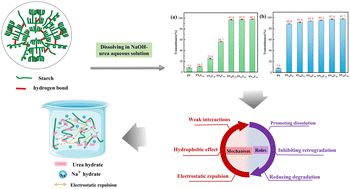The role of urea on the dissolution of starch in NaOH–urea aqueous solutions
Abstract
Potato starch can be dissolved in NaOH–urea aqueous solutions to form a stable and homogeneous mixture to initiate further modification. The mechanism for the formation of such a solution was investigated by examining the interactions between urea and starch, using rheological tests, 13C NMR, FTIR, and a novel Kamlet–Taft solvation parameter analysis. It was found that the optimized dissolution condition was in aqueous 10% w/w NaOH–14% w/w urea, under which 97.4% light transmission was achieved. This was due to dispersive forces between urea and starch without the presence of strong hydrogen bond based interactions. DSC results further showed that the subtle dissolving facilitation of urea might be attributed to the heat released during urea hydrate formation. Compared with conventional hydrothermal gelatinized starch, the starch–NaOH–urea aqueous dispersion exhibited better stability. This highlighted the role of urea in forming a ‘bridge’ to combine starch with water molecules. This reduces the tendency for starch aggregation via its hydrophobic components. Intrinsic viscosity and GPC analysis indicated that the degradation of starch molecules was significantly reduced. This work provides new insights into the role of urea in starch–NaOH–urea aqueous dispersion. This type of starch solvent formulation will have significant potential for further preparation of starch-based materials for various applications.



 Please wait while we load your content...
Please wait while we load your content...